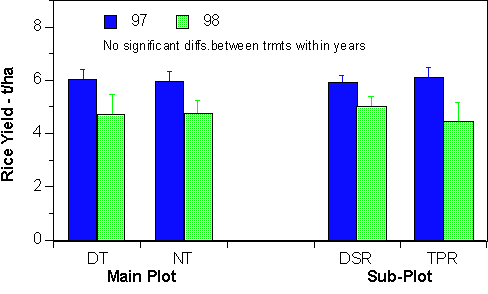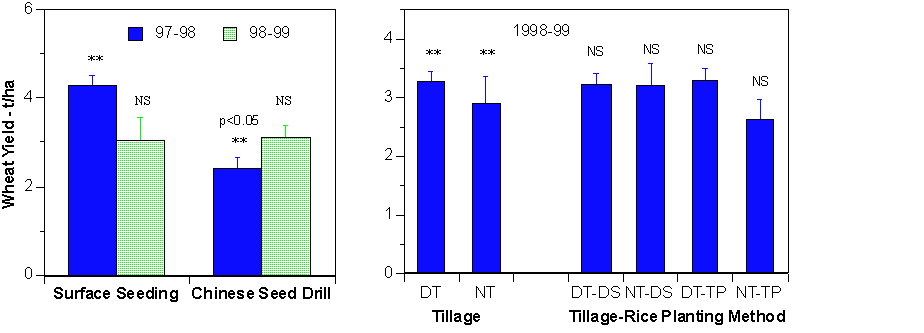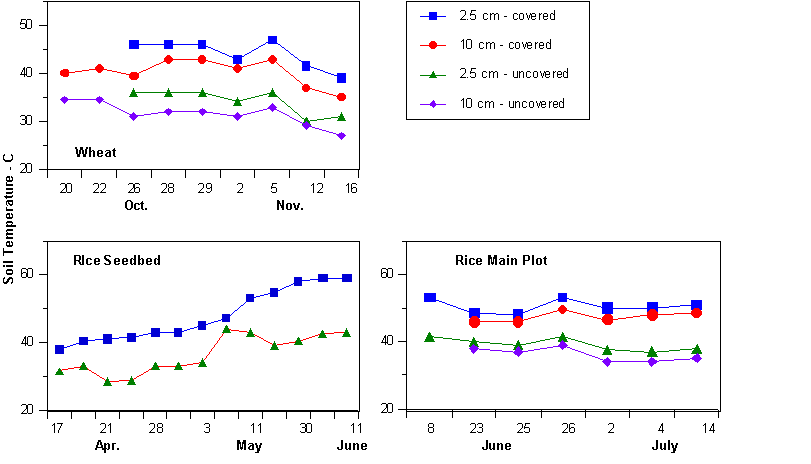
III. Soil Degradation
A. Physical
Puddling of soils for rice production destroys soil aggregates and creates pans that can restrict root penetration. Although puddling is generally considered beneficial for rice, the poor soil structure that it creates interferes with the timely establishment of wheat and often leads to poor crop stands and growth. There is also interest in direct seeding of rice because of projected labor shortages for transplanting. These factors led us to implement tillage experiments to improve the soil environment for wheat and to include different plant establishment techniques for both rice and wheat.
(i) Tillage Experiment 1
This experiment is a split-split plot design with three replications. It consists of two tillage practices prior to rice (deep and normal), two rice crop establishment techniques (puddling and transplanting, and direct seeding with rotovator/drill attachments to a Chinese tractor) and two wheat establishment techniques applied to each rice plot (surface seeding without tillage, and Chinese rotovator/seed drill). The deep tillage consists of deep ripping (50 cm deep on 50 cm centers) followed by two passes with a cultivator. Normal tillage consists of two passes with the cultivator. The experiment is established at NARC research stations at Bhairahawa and Khumaltar. Because weed pressure is a likely constraint with direct seeding, a 3m deep strip across each plot is left unweeded to assess crop loss if no control measures were used (Bhairahawa site only).
Results - Bhairahawa
Rice 1997 -----Wheat 97-98 ------Rice 19982 -------Wheat 98-992 | ||||
NT- TPR- CSD NT- TPR- SS |
5.97a1 * |
2.20a 4.02b |
4.40 4.75 |
|
NT- DSR- CSD NT- DSR- SS |
5.92a * |
2.52a 4.33b |
4.89 5.04 |
|
DT- TPR- CSD DT- TPR- SS |
6.28a * |
2.37a 4.33b |
4.59 4.19 |
|
DT- DSR- CSD DT- DSR- SS |
5.62a * |
2.57a 4.44b |
4.89 5.17 |
|
NT = normal tillage; DT = deep tillage; TPR = transplanted rice; DSR = direct seeded rice;
CSD = wheat planted by Chinese Seed drill; SS = surface seeding of wheat


At Bhairahawa, no significant effects of tillage and either rice or wheat establishment methods on rice yields have been found to date. Surface seeding of wheat immediately after the first rice crop almost doubled crop yields compared to the conventional tillage/drill establishment treatment. This was because rainfall delayed land preparation and conventional wheat planting by 40 days. However, no effect of the rice tillage treatments was seen in this first wheat crop. In contrast to the first year, yields of the second wheat crop were not significantly affected by establishment technique but were significantly higher (p<0.005) with the deep tillage treatment.
In contrast to expectations, weed pressure was not significantly higher with direct seeded rice, probably because plots were flooded most of the time. Fewer weeds were present in surface seeded wheat than with the conventional practice. Wheat yields in the weedy check (no weeding) were reduced by an average of 2.9% with surface seeding and 10.8% with conventional practice.
Results-Khumaltar
The experiment was begun with the 1997-98 wheat season with deep tillage prior to seeding, then again prior to rice. There were no significant effects of tillage or establishment method on yield (mean 2.9 t/ha) with the first wheat crop. However, surface seeding suppressed both grassy and broadleaf weeds and gave more tillers per plant. Also, deep tillage gave greater plant biomass. Possibly these differences did not translate into yield differences because of late planting (Nov 29). Similarly, there were no effects of the treatments on rice yield (mean 6.1 t/ha) in 1998.
(ii) Tillage Experiment 2
This experiment at Khumaltar, Nepal was carried out for 2 years as part of the PhD thesis research of Medha Devare. It explored the effects of deep tillage, water management in rice (grown as paddy or "upland" crop), intercopping rice with blackgram, and solarization on productivity of rice and wheat. The experiment began with the 1997 rice crop and several problems led to low yields of rice in the unflooded and intercrop treatments.
Following the rice crop a deep tillage treatment (same as experiment 1) was done prior to wheat and this treatment significantly (p<0.05) increased wheat yield from an average of 3.0 t/ha to 4.7 t/ha. The design of the experiment was then modified for the second rice-wheat cycle to include sub-plots which were solarized and a deep tillage treatment was again imposed prior to rice.
Puddled NS1 S1 |
Non-Puddled NS S |
NS S | |
| 5.3 7.0 | 5.3 8.0 | 5.0 7.0 | |
| 5.2 7.0 | 3.7 4.7 | 2.3 3.4 |
1 NS = non-solarized; S = solarized
With puddling, tillage had no effect on rice yields. Yields in the non-puddled plots were comparable to those in puddled plots with deep tillage, but were reduced by 1.6 - 1.7 t/ha (30 - 54%) with normal tillage. Solarization increased rice yields by an average of 43% to a high of 8.0 t/ha. Results from this experiment are complicated by differences in depth to water table across the site. Soil-plant-water realtionships are being analyzed in order to more fully interpret the data.
B. Biological
Soil biology is an under researched area of soil science. Our knowledge of micro-flora and fauna species and communities, their functions, and how to manipulate this soil biological ecosystem for the benefit of crop production is limited to a few situations. In a simple crop rotation like rice and wheat, it is likely that populations of organisms that are detrimental to root health have built up in the soil with consequent negative impacts on crop yield. To evaluate this hypothesis, we have carried out surveys of soil borne pathogens and a large number of diagnostic solarization trials.
Solarization is the heating of soil by covering it with clear plastic. Soil microbes begin to be killed at temperatures above 40ÚC, and temperatures above 50ÚC generally provide good control of soil borne pathogens. Solarization can also affect weed and insect populations, and nutrient availability so it not unambiguously diagnostic for soil pathogens or biological problems. Our primary purpose in using solarization is to determine the extent to which soil biology/soil borne pathogens limit yields of rice and wheat, or conversely the yield gains that could be realized if these "soil biological" problems could be overcome. Since solarization on a large scale is not practical, we intend to seek alternate control measures if the diagnostic studies indicate that this is justified. Possible uses of solarization as such would be in rice nurseries and in small areas to produce seed if these practices were to increase crop yields.
Our strategy is to first demonstrate effects of solarization of soil at research centers, then to evaluate its significance across the Indo-Gangetic plains using on-farm tests. Assuming positive results, studies on mechanisms responsible for solarization effects and alternatives to solarization will be carried out at research centers with transfer to on-farm evaluation as soon as is practical.
(i) Solarization Trials
Results
Example of Effects on Soil Temperature

Soil temperatures at 2.5 and 10 cm depths were generally increased by 10-14 °C during solarization and temperatures at the 10 cm depth were generally between 2-6 °C lower than at the 2.5 cm depth. Soil temperatures at 2.5 cm were sustained between 54-58 °C from mid-May to mid-June during solarization of the rice nursery soil. Soil temperatures during solarization of rice main plots (early June to mid-July) were 50±3 °C at the 2.5 cm depth and 46.5±3 °C at the 10 cm depth. Lower soil temperatures of 40-46 °C at 2.5 cm and 34-44 °C at 10 cm were achieved during solarization prior to wheat.
Effects on Yields of Rice and Wheat
| Wheat | |||||
| Joydebpur (s) | |||||
| Jogitola (f) | Residual effect | ||||
| Jogitola (f) | Residual effect | ||||
| Nashipur (s) | |||||
| Nashipur (s) | Residual effect | ||||
| Nashipur (s) | Residual effect w/ micronut. spray | ||||
| Nashipur (f) | Residual effect | ||||
| Nashipur (f) | Residual effect | ||||
| Rice | |||||
| Jogitola (f) | green yields | ||||
| Kaharol (f) | w/ micronut. spray | ||||
| Kaharol (f) | w/o micronut. spray | ||||
| Birgunj (f) | |||||
| Sipaghat (f) | |||||
| Nashipur (s) | w/o micronut. spray | ||||
| Nashipur (s) | w/ micronut. spray | ||||
| Khumaltar (s) | deep till prior to rice |
To date we have carried out a total of 34 solarization trials in Bangladesh, India and Nepal. Efforts to solarize prior to wheat were limited by cool weather patterns during winter. Since this would not be possible anyway in a rice-wheat rotation, the majority of the solarizations were done before summer rice. Selected yield results are presented in the following table:
Of the 23 studies with rice, 13 showed yield increases due to solarization, ranging from 0.5 to 3.0 t/ha (15 to 70% increase over the control). Wheat yield increases following solarization were found in 8 of 11 trials, ranging from 0.4 to 0.7 t/ha (13-36% increase over the control). Several trials did not give a yield response to solarization; however, we observed that the solarized plots often had more lodging and insect damage due to vigorous and lush plant growth, thereby selectively reducing yields on solarized plots. Other plant parameters such as populations, height, tillers per plant, and aboveground biomass as well as pathological variables like root health ratings and nematode gall counts showed consistently positive responses to solarization treatment at almost all sites. Our results clearly demonstrate that yield potential is almost always increased but not always achieved with solarization.
| Gazipur (BARI) | |||
| Gazipur (BRRI) | |||
| Chuadanga Farm 1 | |||
| Chuadanga Farm 2 | |||
| Chuadanga Farm 3 | |||
| Gazipur (BARI) | |||
| Chuadanga Farm 1 | |||
| Chuadanga Farm 2 | |||
| Gazipur (BRRI) | |||
| Khumaltar (NARC) | |||
| " | |||
| Gazipur (BRRI) 29 DAS | |||
| Gazipur (BRRI) 55 DAS | |||
| Chuadanga Farm 1 | |||
| Siphaghat Farm |
1S = solarized; NS = non-solarized
Solarization increased inorganic N by a factor of 1.7-2.4 and available manganese by 3.8 times. Weed and nematode populations were drastically reduced by solarization. Despite these beneficial changes in nutrient release, weed populations and nematodes, only one of these trials showed a significant yield response which correlated to a change in weed population (Khumaltar, NARC). Future efforts will focus on characterizing the dynamics of soilborne pathogens and nutrient availability following solarization and then relating the observed changes to beneficial effects on crop growth and yield.
(ii) Pathology Surveys
Broad surveys have been initiated to determine if there is an association between the prevalence and diversity of soilborne pathogens and rice-wheat production. Dinajpur and Gazipur districts in Bangladesh and Rupandehi (terai) and Naldung (mid-hills) districts in Nepal were chosen for the surveys. "Normal/Good" and "Declining/Poor" rice-wheat fields were identified based on previous farmer monitoring efforts. All sites were geo-referenced for later use with GIS. Rice roots and soils were sampled from these fields during the 1998 rice season. Emphasis was placed on identifying nematodes during the first survey, but later surveys also included parasitic fungi and bacteria.
Results from the initial surveys showed that on average in Bangladesh, there were twice as many identifiable parasitic nematodes in wheat (643/100g soil) as in rice (386/ 100g soil). Of the wheat parasitic nematodes, Meloidogyne (root-knot nematode) dominated (72%), followed by Tylenchorynchus (15%; stunt nematode). In the rice soils of Dinajpur, 53% of the total counts were Tylenchorynchus with only 16% as Hirschmaniella. (rice root nematode). Nematode counts from the Nepali sites were substantially lower than the Bangladesh sites (0.3-1.9/100g soil). Hirschmaniella dominated the counts, especially in heavier textured soils. The unexpected low nematode counts in Nepal may be due to sampling time, extraction techniques or other factors. Optimal sampling time for rice root nematode is at maximum tillering; however most of the Nepal and Bangladesh samples were taken at late flowering.
Rice yield information was insufficient to make comparisons with the nematode counts from the Bangladesh survey, and no correlation between nematode counts and rice yield levels was found in the Nepal survey. As previously noted in the literature, the highest levels of Hirschmaniella were found in the heavier textured soils of both countries.
Fungi isolated from discolored crop root segments revealed Fusarium on 45-64%; Bipolaris sorokiana on 8-18% and Curvalaria on 6-26% of the wheat roots collected from Gazipur and Dinajpur, Bangladesh. Rice roots were about equally infected with Curvalaria (16%), Fusarium (11%) and Phoma (12%). Pathogenicity tests are being performed on the Fusarium isolates, while fungi isolated in Nepal are still undergoing identification. In the future, rice and wheat yield information will be gathered from the same plots to correlate with the pathogenic nematode and fungal counts.